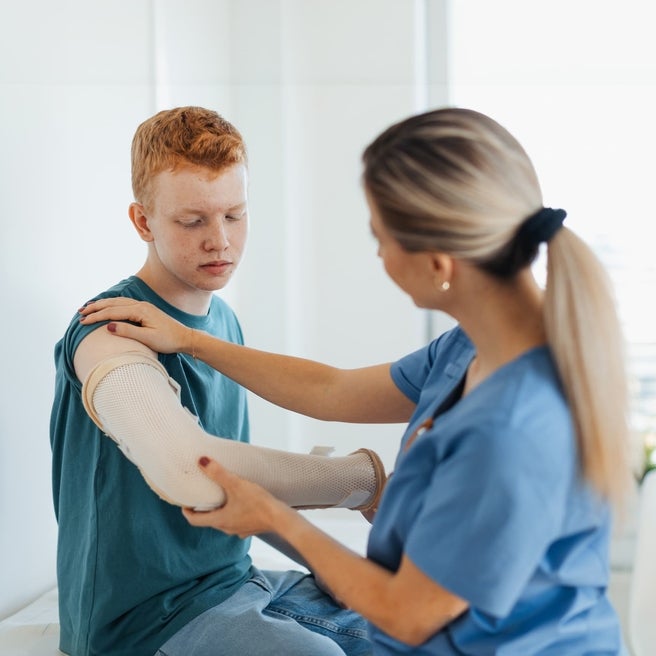What is a dislocation?
A dislocation occurs when extreme force is put on a ligament, allowing the ends of 2 connected bones to separate. Ligaments are flexible bands of fibrous tissue that connect various bones and cartilage.
Ligaments also bind the bones in a joint together. Stress on joint ligaments can lead to dislocation of the joint. The hip and shoulder joints, for example, are called "ball and socket" joints. Extreme force on the ligaments in these joints can cause the head of the bone (ball) to partially or completely come out of the socket.
The most commonly dislocated joint is the shoulder.
Dislocations are uncommon in younger children because their growth plates (area of bone growth located in the ends of long bones) are weaker than the muscles or tendons; instead, children are more prone to a fracture than a dislocation.
What are the symptoms of a dislocation?
The following are the most common symptoms of a dislocation. However, each child may experience symptoms differently. Symptoms may include:
- Pain in the injured area
- Swelling in the injured area
- Difficulty using or moving the injured area in a normal manner
- Deformity of the dislocated area
- Bruising or redness in the injured area
- Numbness or weakness in the injured area
The symptoms of a dislocation may resemble other medical conditions. Always consult your child's doctor for a diagnosis.
How is a dislocation diagnosed?
The doctor makes the diagnosis with a physical examination. During the examination, the doctor obtains a complete medical history of the child and asks how the injury occurred.
Diagnostic procedures may help to evaluate the problem. Diagnostic procedures may include:
- X-ray. A diagnostic test that uses invisible electromagnetic energy beams to produce images of internal tissues, bones, and organs onto film.
- Magnetic resonance imaging (MRI). A diagnostic procedure that uses a combination of large magnets, radiofrequencies, and a computer to produce detailed images of organs and structures within the body. An MRI is only likely to be done if your doctor is considering surgery.
Treatment for dislocation
Specific treatment for a dislocation will be determined by your child's doctor based on:
- Your child's age, overall health, and medical history
- The extent of the injury
- The type of injury
- Your child's tolerance for specific medications, procedures, or therapies
- Expectations for the course of the condition
- Your opinion or preference
All dislocations require immediate medical attention since fractures can also occur with dislocations.
Initial treatment of a dislocation includes R.I.C.E. (rest, ice, compression, and elevation). Dislocations may reduce spontaneously, meaning the bone ends may go back into place by themselves. However, for those dislocations that do not go back into place, your child's doctor will need to place the joint back into its proper position so it will heal. Your child will receive sedation to help him or her remain comfortable before the procedure. Sedation will also help the muscles around the dislocated joint relax, so the joint can be put back into place more easily.
Your child's doctor may recommend any of the following to help reduce the dislocation or promote healing afterwards:
- Splint or cast, which immobilizes the dislocated area to promote alignment and healing; protects the injured area from motion or use
- Medication (for pain control)
- Traction is the application of a force to stretch certain parts of the body in a specific direction. Traction consists or pulleys, strings, weights, and a metal frame attached over or on the bed. The purpose of traction is to stretch the muscles and tendons around the bone ends to help reduce the dislocation.
- Surgery (especially for reoccurring dislocations or if a muscle, tendon, or ligament is badly torn)
Additional recommendations may include:
- Activity restrictions (while the dislocation heals)
- Crutches or wheelchair (to enable your child to move around during healing)
- Physical therapy (to stretch and strengthen the injured muscles, ligaments, and tendons)
Long-term outlook after a dislocation
While dislocations are rare in younger children, they do occur more frequently among adolescents. It is important that the child adhere to the activity restrictions and/or stretching and strengthening rehabilitation programs to prevent reinjury.

Why choose CHOP
We have more specially trained sports medicine physicians, orthopedic surgeons, physical therapists and athletic trainers than any other pediatric orthopedic facility in the region.
Resources to help
Sports Medicine and Performance Center Resources
We have created resources—including patient and family educational materials, videos, and more—to help you find answers to your questions and feel confident about the care you are providing your child.
